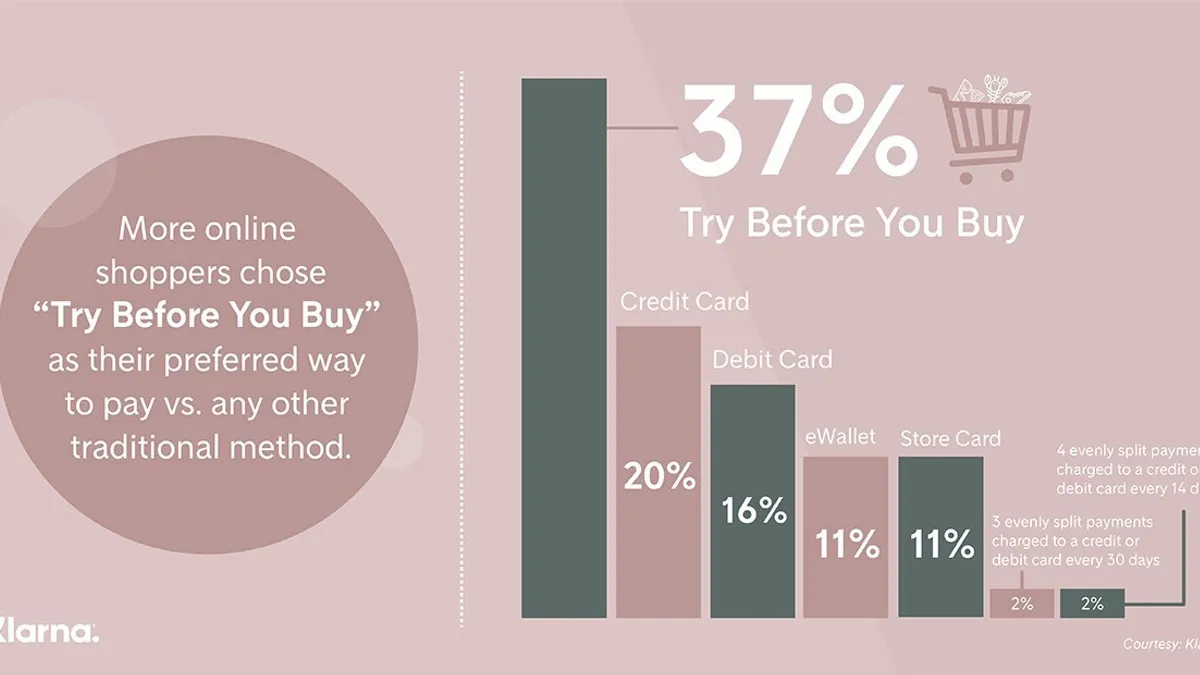Dive Brief:
-
North American consumers still hesitate when it comes to online apparel shopping because of the inability to try on clothes before buying, according to research from Stockholm-based bank and payment provider Klarna . Nearly three quarters (74%) say that having the ability to try on or try out goods before paying would mitigate that, Klarna noted in a press release.
-
Nearly as many (71%) said they would be "moderately, very or completely" likely to choose a retailer offering a so-called "try before you buy" option over one that didn’t, and 69% said they were "moderately, very or completely" likely to buy more items from online merchants offering it.
-
While many merchants offer free returns, such options don't give consumers a set amount of time to evaluate goods before they’re billed. The option to try before they buy ranked as the number one preferred payment option (favored by 37%) for buying apparel from an online retailer. This eclipsed others, including using credit cards (20%), debit cards (16%), PayPal or store credit cards (11% each), or evenly splitting payments (2% each for three payments every 30 days or four every 14 days).
Dive Insight:
Plenty of shoppers still prefer stores. Despite runaway growth in e-commerce, brick-and-mortar remains the top venue for shoppers and apparel buyers in particular, are keen on the "try before you buy" inherent in physical locations.
Indeed, an A.T. Kearney survey found that among those who prefer to buy online, fully two-thirds say they still rely on a physical store either before or after their purchase, Andres Mendoza Pena, a partner in global management consulting firm A.T. Kearney’s retail practice, told Retail Dive last year. "That means that when you're buying a dress online, it's likely that you're going to be looking at that dress — the feeling, the color — and to do that, you leverage a physical environment prior to the purchase."
Consumers themselves are attempting to replicate that brick-and-mortar option by buying several iterations of an item, with plans to return what they don't want, and that's fueling returns. Post-purchase solutions Narvar has found that, on average, 40% of those buying apparel and home goods online do at least occasionally buy more than they want, and that 22% of apparel shoppers won't make an online purchase if they don't have the option of returning to a store.
The value of retail returns last year rose 53% from 2015 to $400 billion and the growth of e-commerce is stoking that, according to returns and overstock supply company B Stock. Returns of brick-and-mortar purchases tend to hover at 8%, while e-commerce returns can reach as high as 15% to 30%, according to CBRE, which says that the likely value of online returns at the holidays last year was $32 billion, up from 2016's estimated $28 billion.
Stitch Fix and Amazon, among others, are trying to solve that with various iterations of "try before you buy." After taking another 1.5% of market share in U.S. apparel sales last year, Amazon is edging closer to becoming the nation’s top apparel retailer, according to a note from Morgan Stanley earlier this year, and its Prime Wardrobe service, where participants only pay for what they keep, could well be a factor. That program still hasn't officially launched, though Amazon Fashion extended it widely in April.














